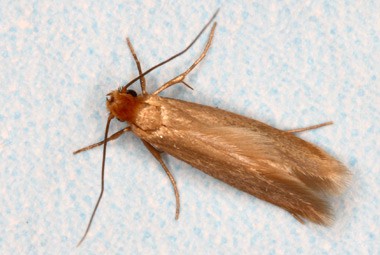
Casemaking clothes moths are a type of stored product pest that feed on animal and plant by-products. They can cause a lot of damage to stored items and become quite difficult to eliminate without professional help. These pests can be found throughout the United States but are more common in the southern states.
| Pest Identification | |
|---|---|
| Recognition | Adult casemaking clothes moths can grow to be 3/8 to ½ of an inch in length. Their long narrow wings are brownish-gray in color. In very young adult moths the wings will have three dark spots on them, however the spots may not be present in older moths because they can rub off. The larval stage is grub-like in appearance and cream or yellowish in color. They grow up to ½ of an inch in length. The larva has one eye on each side of their head. The casemaking clothes moths are aptly named because the larva will create a case of silk particles that it lives in and takes with them as they feed. The case can be difficult to spot because it is often the same color as whatever the moth is feeding on. |
| Biology | When the female and male casemaking clothes moths emerge from their pupae stage, they immediately mate. The very next day the female will start to lay her fertilized eggs. She lays her eggs on either an animal or plant product. This ensures that when the larva hatch they have something to feed on. During the larva stage they feed and molt many times. This stage can last 33-90 days. After the larva has matured, they then encase themselves in the material that they are feeding on. Then they pupate. The length of this stage is temperature and humidity dependent. When this is complete, the larva will emerge from the pupae as an adult, thus starting the cycle over once again. |
| Habits | Both adult female and male casemaking clothes moths do not like bright light and are therefore found living in dark, quiet storage areas like closets, basements, and attics that are close to their food sources. An infestation often goes unnoticed until homeowners find damaged items that they have removed from storage because they are hidden away. It is actually the larval stage of this moth that causes damage. The adults do not eat. They live for only a few short days (females 3-8 days, males 3-5 days) in order to mate. The larva feed on items throughout homes and storage facilities containing natural fibers. Adult moths have wings but rarely fly. In fact when they are disturbed they will scurry away instead of flying away. |
| Prevention | In order to prevent casemaking clothes moths from invading items in your home, you need to make sure to properly store clothing and other things made of wool or natural fibers. Before storing fabric items they should be washed or dry-cleaned. Then place them into airtight sealed garment bags or boxes. Furniture and rugs that are within your home should be professionally cleaned on a regular basis. You should also make sure to routinely vacuum and dust your home to remove pet hair and other dust and debris. |
| Professional | To effectively get rid of casemaking clothes moths from your home, a professional should inspect it and determine which treatment method is best to be used to safely eliminate them. A Rottler technician will help you to identify infested items so that they can be cleaned. The Rottler technician will use appropriate materials and products to treat closets and other storage areas within your home, based on the severity of the infestation. |

